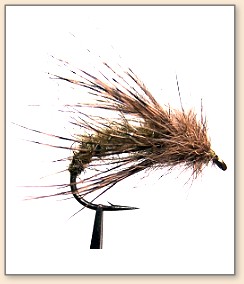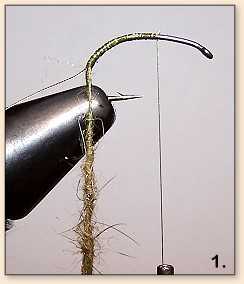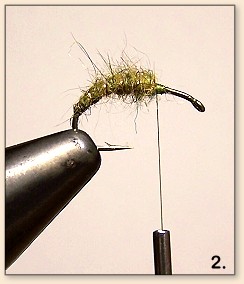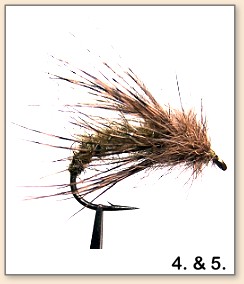Triple Threat Caddis
By Jim Slattery, CA
Not having much luck with caddis larva or
pupas made me step back and examine what
characteristics flies that were effective
for me have. I soon figured out that my go
to flies like the Gold Ribbed Hares Ear Nymph,
March Brown Spider, and Soft Hackles all had
a tremendous amount of built in movement,
giving the fly "life." Then I looked at
dry flies. The hackled classic style especially
with grizzly or mixed colored hackle, the Dorato
Hare's ear, and Elk Hair Caddis, which were the
only trout producing caddis patterns I had used,
The Fluttering Stonefly (AKA the Stimulator) were
all effective patterns. Each of these dry fly
patterns had one thing in common, they gave the
illusion of movement which in turn made them "deadly."
After looking at the caddis pupa and larva I was
using I came to one conclusion: They had little
to no movement. Incorporating the properties of
effective flies with the form of the caddis fly
resulted in this solution: The Triple Threat
Caddis.
Fished as a nymph, bounced on the bottom of the
stream or fished as a soft hackle in the water
column, the results were immediate, trout took
it! I had finally found a submerged caddis
pattern that worked consistently, anywhere
it was fished.
However, the final use of this fly was over
looked by me, until by accident, in my haste
to get fishing, I didn't soak the fly, and as
it floated down stream it was taken by a nice
trout. Now I had a new dry fly solution for
caddis as well. The Triple Threat is a fly that
can be fished through out the caddis hatch as
well as the life cycle. As a dry, it can be
fished with or without floatant. It also works
with just floatant on the hare's ear head,
allowing the rest of the fly to stay below
the surface. With the body pulsating and
the hackles kicking with the currents of
the water, don't be surprised if the trout
jump out of the water when taking it this way!
A Few Tips on Tying the Triple Threat Caddis
- Use a blend of different types of dubbing
materials Hares ear, Rabbit, Antron Seal ex, Seal,
and Angora goat in various shades to get the
overall color.
- I've found dubbing the body using Jim
Leisenring's technique makes a difference, but
the standard method will work too just pick
out the dubbing to make it shaggy.
Materials for Triple Threat Caddis
Hook: Scud, Caddis Larva.
Thread: Olive Uni 8/0.
Ribbing: Gold oval tinsel (fine or extra fine).
Body: Olive blend.
Hackle: Natural brown Partridge.
Head: Spun natural hare's ear.
Instructions for Triple Threat Caddis:
|





